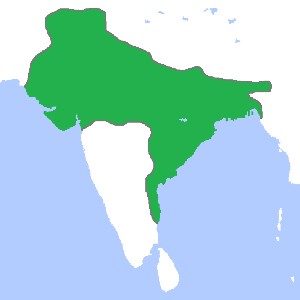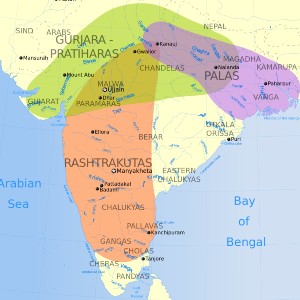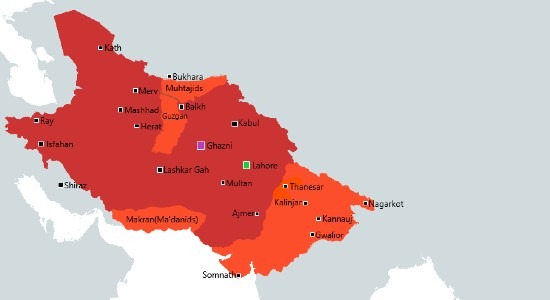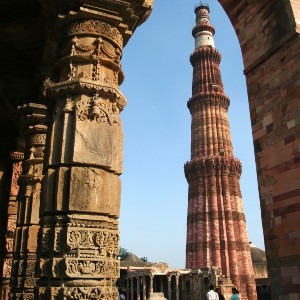MedievalReporter.com
Covering history's most marvelous millennium
Join our newsletter!

Covering history's most marvelous millennium
Covering history's most marvelous millennium
The Indians were one of the major civilizations of the Middle Ages. As one of the largest economies and population centers of the era, they were perfectly content with trading (and warring) among themselves when external circumstances worsened. With the world’s highest mountain range shielding its northern border and an ocean to its south, this gave the Indian subcontinent an enviable amount of stability.
Outside pressure mounted over time, though. The Indians beat back the first round of Islamic invasions but the muslim menace continued to grow. With the subcontinent divided, it became increasingly hard for India to withstand the tide of external aggression.
This is a short intro from our Medieval Guidebook. Dive deeper into the subject by reading our articles about it.
Medieval India began with the late classical Gupta Empire fading out of history between 480 and 550 CE. It buckled under the weight of Hunnic invasions, not unlike the Western Roman Empire. Although the Gupta army managed to defeat the Huns in the end, their devastating raids had greatly damaged India’s commercial potential. The Guptas had grown rich from trading their wares along the Silk Road to clients such as the Roman Empire. With commerce now in full decline, the authority of the Gupta emperors swiftly evaporated.

Several rulers took up the mantle of command over the Indians. But none of them was able to dominate the others. In fact, one historian estimated that – until the rise of the Delhi Sultanate – over twenty dynasties coexisted at any point during the Indian Middle Ages. The loss of trade with the “outside world” didn’t hurt these kingdoms as much because they turned inward for mercantile opportunities. India was a major market in and of itself: with an estimated population of 70 million, it made up roughly 30% of the global economy at the time.
Indian religion also changed significantly after the collapse of the Gupta Empire. The emperors had been staunch supporters of Buddhism. But the new kings dividing the Indian subcontinent leaned more towards the Hinduist side. Over the course of centuries, Hinduism enjoyed increasing popular and official support thanks to religious innovations such as emotional devotionalism. The last dynasty to sponsor Buddhism, the Pala Empire, fell in the 12th century CE.

The Gurjara-Pratiharas were instrumental in the survival of medieval India, for they controlled the “door” to the subcontinent. As it happened, the new religion of Islam was storming east and had already overwhelmed the prestigious Persian Empire. Now, the caliph sent mighty armies to subjugate the Indians as well. Since the Gurjara-Pratihara kingdom was located to the northwest (partially in present-day Pakistan), the task of withstanding the Arab onslaught fell upon this dynasty. It took them great effort, but their victories over the muslims also earned them great prestige.
At the peak of their power, the Gurjara-Pratiharas rivaled the ancient Gupta Empire in size. Indeed, the now imperial Pratiharas began styling themselves not just as maharaja (“great king”) but as maharajadhiraja (“great king of kings”). The other kingdoms were not standing idly by, however. Soon, most of India was divided through a rather neat – if often bloodily contested – balance of power called the Tripartite Struggle. By this outline,

This division of territory worked for a while, waxing and waning with the tide of time all historical realms are subject to. But over time, the Struggle eroded the imperial claims of the Gurjara-Pratiharas. More and more vassals declared their independence from the once-mighty kingdom.
As a result, the dynasty that was supposed to guard the door to India was unprepared for a new wave of muslim invasions.
– advertisement –
– article continues below –
The second round of Islamic attempts to annex India came in three stages: the Ghaznavids, the Ghurids and the Delhi Sultanate.
The Ghaznavids hailed from Ghazna, a city in modern Afghanistan. They were of Turkic origin, but highly “Persianized” in culture. Their second king led 17 (!) expeditions into Northern India, exploiting the weakness of the Gurjara-Pratihara kingdom. The enormous amount of loot and plunder financed Ghazna’s transformation into one of Islam’s most splendid cities. The Ghaznavids captured the Pratihara capital in 1018, putting its last monarch to flight.

After this triumph, the Ghaznavid empire was plagued by succession struggles and foreign invasions as the Seljuqs stormed through Afghanistan and Persia during the 11th century. An Iranian dynasty, the Ghurids (named after the Ghur region in Central Afghanistan), profited from the confusion and burned Ghazna during a 7-day sack that earned the Ghurid king the title of “World Burner”. The Ghurids then turned their attention to India. They battled with the Chauhans, who had taken over Rajasthan in the west during the Gurjara-Pratihara collapse. The popular and flamboyant Chauhan king at first managed to beat back the Ghurids, but over time the systematic muslim war of expansion proved too much to handle.
Whereas the Ghaznavids had mainly raided, the Ghurids set up a sultanate on Indian ground. Sunni Islamic in religious matters, the state didn’t last long as its first sultan was murdered by Shi’ites. In the long run, this had little impact: the muslims had wrestled their way into India and were here to stay. A former slave of the Ghurid sultan took control and founded the Sultanate of Delhi. It would conquer most of the Indians over the following centuries; was one of the few states globally to resist Mongol conquest; and, although it devastated many Hindu and Buddhist holy sites, gave rise to beautiful Indo-Islamic architecture.
With over 170 million muslims in modern India, the influence of the Delhi Sultanate continues to be felt to this very day.

Disclosure: we work hard to provide you with exclusive medieval reports and guides. To make the Middle Ages accessible to everybody, we’d like this information to remain FREE. Therefore, some of the links below are affiliate links, meaning – at no additional cost to you – we will earn a small compensation if you click through.
Grab a short intro on another civilization from our Medieval Guidebook.